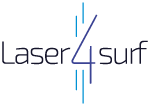An international group of researchers are exploring how tiny changes to surfaces using laser structuring can alter and improve the properties or performance of metals – and aim to bring the technology to mass production. Remarkably, it could mean everything from faster charging and more powerful batteries in electric vehicles, to quicker healing and more hygienic medical components.
The properties of a surface define how materials interact and behave with one another, right down to the cellular level. An explosion in laser power and innovative techniques to structure surfaces at ultra high precision (<1 micron scale) is leading to a whole new dimension of interactions being opened up.
A new European funded research project, Laser4surf, is using femtosecond pulse lasers with– a laser pulse that lasts one quadrillionth of a second – to create precision scratches, lines and patterns just microns apart on materials such as aluminium, titanium, copper and stainless steel. The created textures give new functionalities, like hydrophobicity, lubrication, anti-condensation, enhanced or reduced adhesion or even anti-bacterial properties to products. Microscopic texturing can even fine tune optical behaviours to create anti-reflection ‘black metals’.
“The real world benefits of such tiny surface changes are extensive,” says Yago Olaizola of Spanish research institute CEIT and acting project coordinator. “Very small, very predictable corrugations in a prosthetics pin for instance can help boost the way cells interact and bind together. The better adhesion attained means a quicker recovery in the patient and subsequent benefits such as less money spent in aftercare or rehabilitation”.
Medical components is just one of three areas of application being examined by Laser4surf, which will also aim to accelerate submicron surface texturing applications in advanced manufacturing and batteries. In a world increasingly looking to electric vehicles and ways to create a new energy transition, the second of these has considerable interest for greater application. “By increasing the surface area of the battery we can increase the current-rate capability, creating batteries that charge faster and last longer” Olaizola outlined.
Previous techniques to add texture to products include sandblasting without precision or patterning or adding carbon coatings using advanced manufacturing techniques. Huge leaps forward in laser technology are a driving force behind the advances, with exponential growth in power meaning that current 100watt lasers will be dwarfed by 1 and even 2 kilowatt lasers expected to become available over the next 2-5 years. Only extreme precision and these latest laser capabilities can create or maximise the desired effects or behaviours.
The age-old problem with this very new technology: time and money. “Increasing the industrial robustness of the process is key to Laser4surf”, the project coordinator said. “Our job is to take sub atomic texturing out of a purely research environment and into mass production. Making it faster and at least affordable will open up a vast amount of possibilities,” he continued.
No mean feat ahead. Today, capacity for submicron surface texturing is limited and very time consuming. Over the next three years, Laser4surf will seek to double the surface area textured and make it 95% faster.
This project has received funding from the European Union’s Horizon 2020 research and innovation program under grant agreement No 768636. You can follow their journey @laser4surf .
